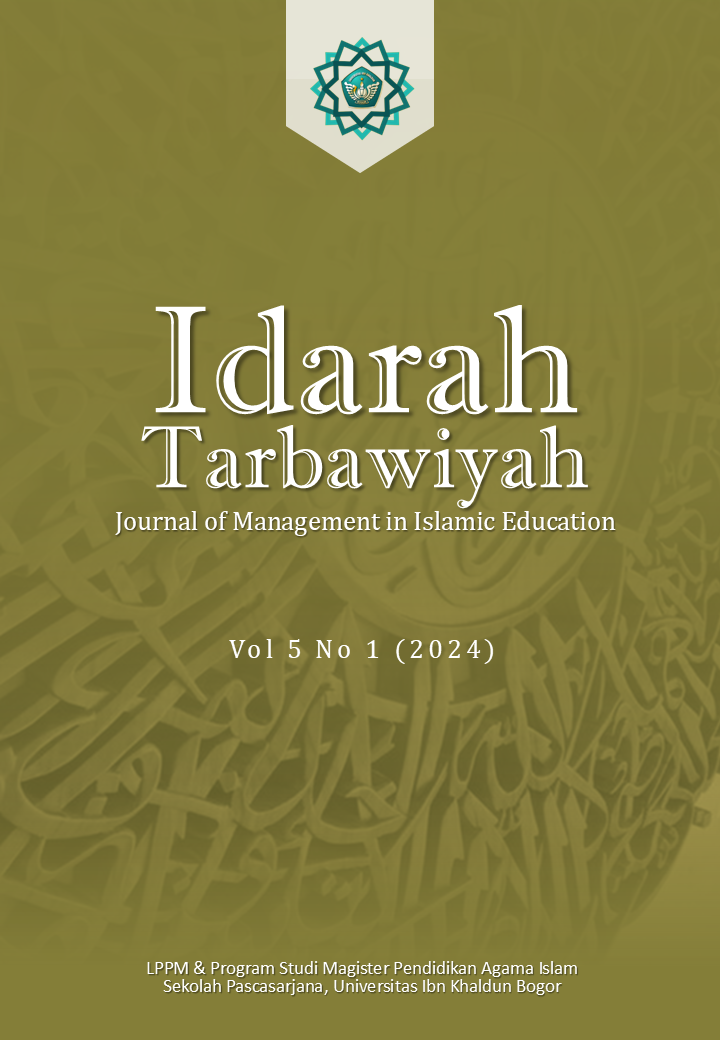STRATEGI PEMBELAJARAN BACA TULIS AL-QUR’AN BERDASARKAN KECENDERUNGAN GAYA BELAJAR PESERTA DIDIK DI MA GAZA AL-ISLAMI BOGOR
DOI:
https://doi.org/10.32832/itjmie.v5i1.15958Abstrak
The BTQ program is Education to practice reading the Qur'an for children, then reading the Qur'an is absolute done from an early age as a provision for life in the world and at the end. This study aims to: (1) To find out the purpose of learning to read the Qur'an writing in MA Gaza Al-Islamic Bogor. (2) To find out what method used in reading the Qur'an written at MA Gaza Al-Islamic Bogor. (3) To find out how the tendency for students’ learning style in the Qur'an writing process at MA Gaza Al-Islamic Bogor. (4) To find out how the Teacher's strategy is to learn to read the Qur'an writes in MA Gaza Al-Islamic Bogor. The method used in this study are qualitative research methods with a field approach (field research), data sources are obtained from observations, interviews, documentation carried out at MA Gaza Al-Islam Bogor. The conclusion of this study is as follows: Basically the purpose of implementing learning Read Al-Qur'an to dig into the potential of students in reading and being able to write the AL-Qur'an by deepening the contents of the content, there are two methods used at MA Gaza Al-Islam on the implementation of the Qur'an learning Write, namely the first binnadzhor, and the two basic letters that have not known. Visual, Auditive, and Kinestic learning styles theory (VAK), learning that emphasizes that learning should take advantage of the sense tools that students have. The teacher's strategy is to improve the reading ability and write the Qur'an learners at MA Gaza Al-Islamic, namely: paying attention to learners’ abilities, observing and choosing a method.
Referensi
Aprilia, A. (2023). Strategi Pembelajaran Baca Tulis Al-Quran Dalam Meningkatkan Kemampuan Membaca Dan Menulis Al-Quran Pada Siswa SMP Swasta PAB 2 Helvetia. Educate: Jurnal Ilmu Pendidikan dan Pengajaran, 2(1), 65–82.
Hasiwa, A. P., & Darwis, M. (2023). Analisis Faktor yang Mempengaruhi Rendahnya Kemampuan Membaca dan Menulis Alquran. JLEB: Journal of Law, Education and Business, 1(2), 678–685. doi: 10.57235/jleb.v1i2.1112
Ma’mun, M. A. (2018). Kajian Pembelajaran Baca Tulis Alquran. Jurnal Annaba’STIT Muhammadiyah Paciran, 4(1), 2–10.
Mansur, S. (2011). Studi Agama Islam. FUDPRESS. Diambil dari http://repository.uinbanten.ac.id/3334/1/STUDI%20AGAMA%20ISLAM.pdf
Maulana, R. (2017). Motivasi Siswa SMAN 1 Kota Jantho dalam Membaca Alquran (PhD Thesis, UIN Ar-Raniry Banda Aceh). UIN Ar-Raniry Banda Aceh. Diambil dari https://repository.ar-raniry.ac.id/id/eprint/1906/
Maulidiyah, A. (2023). Upaya Meningkatkan Kemampuan Baca Tulis Alquran Dengan Metode Demonstrasi Pada Siswa Kelas III Di SDN Lambangkuning Probolinggo. COMPETITIVE: Journal of Education, 2(2), 81–93. doi: 10.58355/competitive.v2i2.18
Nadirah, S. P., Pramana, A. D. R., & Zari, N. (2022). Metodologi penelitian kualitatif, kuantitatif, mix method (mengelola Penelitian Dengan Mendeley dan Nvivo). CV. Azka Pustaka.
Nurjayanti, D., Pudyaningtyas, A. R., & Dewi, N. K. (2020). Penerapan Program Taman Pendidikan Alquran (Tpa) Untuk Anak Usia Dini. Kumara Cendekia, 8(2), 183–195.
Nurseha, A., & Saputra, A. (2023). Upaya Guru PAI Dalam Mengatasi Kesulitan Belajar Baca Tulis Al-Quran. Journal of International Multidisciplinary Research, 1(2), 1062–1073.
Rahman, M. H., Kencana, R., & NurFaizah, S. P. (2020). Pengembangan nilai moral dan agama anak usia dini: Panduan bagi orang tua, guru, mahasiswa, dan praktisi PAUD. Edu Publisher.
Tibamani, S. (2020). Metode guru Alquran Hadits dalam mengatasi kesulitan baca tulis Alquran siswa kelas III MI Al-Madaniyah Jempong Barat Tahun Pelajaran 2019/2020. UIN Mataram, Mataram.
Yani, A. (2020). Tujuan Inti Pesan Wahyu Alquran. Jurnal STIU Darul Hikmah, 6(1), 30–44.
Unduhan
Diterbitkan
Cara Mengutip
Terbitan
Bagian
Lisensi
Hak Cipta (c) 2024 Aisyah Salsabila, Chodidjah Makarim, Bahrum Subagiya

Artikel ini berlisensiCreative Commons Attribution-ShareAlike 4.0 International License.

This work is licensed under a Creative Commons Attribution-ShareAlike 4.0 International License.








